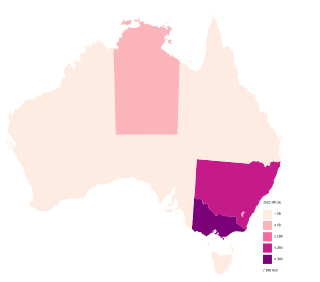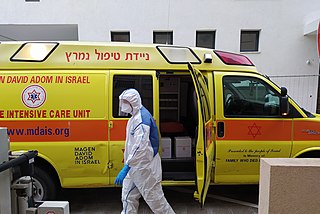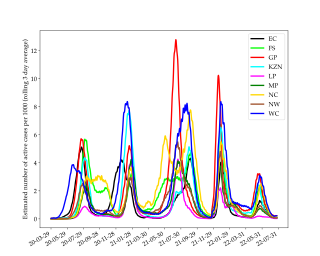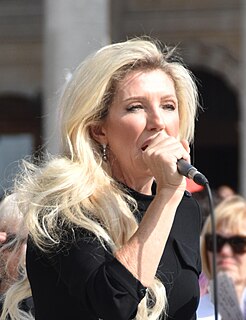
Piers Richard Corbyn is an English weather forecaster, businessman, activist, anti-vaxxer and conspiracy theorist. He is the elder brother of former Labour Party leader Jeremy Corbyn.

The COVID-19 pandemic in the United Kingdom is part of the worldwide pandemic of coronavirus disease 2019. The virus reached the UK in late January 2020. As of 12 August 2021, there had been more than 6.1 million confirmed cases and 120,701 deaths among people who had recently tested positive – the world's twentieth-highest death rate by population and the second-highest death toll in Europe after Russia. There has been some disparity between the outbreak's severity in England, Scotland, Wales and Northern Ireland – health in the UK is devolved, with each country having its own publicly funded healthcare system and government.

The COVID-19 pandemic in Australia is part of the ongoing worldwide pandemic of the coronavirus disease 2019 caused by severe acute respiratory syndrome coronavirus 2. The first confirmed case in Australia was identified on 25 January 2020, in Victoria, when a man who had returned from Wuhan, Hubei, China, tested positive for the virus.

The COVID-19 pandemic in Israel is part of the worldwide pandemic of coronavirus disease 2019 caused by severe acute respiratory syndrome coronavirus 2. The first case in Israel was confirmed on 21 February 2020, when a female citizen tested positive for coronavirus disease 2019 at the Sheba Medical Center after return from quarantine on the Diamond Princess ship in Japan. As a result, a 14-day home isolation rule was instituted for anyone who had visited South Korea or Japan, and a ban was placed on non-residents and non-citizens who were in South Korea for 14 days before their arrival.

The COVID-19 pandemic in South Africa is part of the ongoing pandemic of coronavirus disease 2019 caused by severe acute respiratory syndrome coronavirus 2. On 5 March 2020, Minister of Health Zweli Mkhize confirmed the spread of the virus to South Africa, with the first known patient being a male citizen who tested positive upon his return from Italy. The first death to have occurred from the disease was reported on 27 March 2020.
The COVID-19 pandemic was confirmed to have reached Cyprus in March 2020. The released data from the Cyprus government includes cases in the British Overseas Territory of Akrotiri and Dhekelia but, due to the long-running Cyprus dispute, does not include cases in Northern Cyprus.

The COVID-19 pandemic in Bangladesh is part of the worldwide pandemic of coronavirus disease 2019 caused by severe acute respiratory syndrome coronavirus 2. The virus was confirmed to have spread to Bangladesh in March 2020. The first three known cases were reported on 8 March 2020 by the country's epidemiology institute, IEDCR. Since then, the pandemic has spread day by day over the whole nation and the number of affected people has been increasing. Bangladesh is the second most affected country in South Asia, after India.

There have been protests and demonstrations around the world against national responses to the ongoing COVID-19 pandemic by governmental bodies. Various strikes have also occurred. Some of the protests have criticized governments for not acting more sufficiently in their responses to the pandemic, while on the contrary, others have been opposed to preventative measures and called for their revocation. According to analysis as part of the Global Peace Index, as of July 2021, there have been around 50,000 protests linked to the pandemic worldwide, 5,000 of which were violent.

Beginning in mid-April 2020, there were protests in several U.S. states against government-imposed lockdowns in response to the COVID-19 pandemic in the United States. The protests, mostly organized by conservative groups and individuals, decried the economic and social impact of stay-at-home orders, business closures, and restricted personal movement and association, and demanded that their respective states be "re-opened" for normal business and personal activity.
The COVID-19 pandemic in Toronto is an ongoing viral pandemic of coronavirus disease 2019 (COVID-19), a novel infectious disease caused by severe acute respiratory syndrome coronavirus 2 (SARS-CoV-2). Toronto is the most populous city in Canada, and the fourth most populous city in North America. Toronto is considered to have the longest continuous COVID-19 lockdown of any major city in the world.
There have been several COVID-19 anti-lockdown protests in New Zealand held in 2020, where people protested the government's response to the COVID-19 pandemic in New Zealand, in particular the lockdown measures in place in March–May and August 2020.

Kay Allison "Kate" Shemirani is a British conspiracy theorist, anti-vaxxer and former nurse who lost her licence to practise in 2020 for misconduct. She is best known for promoting conspiracy theories about COVID-19, vaccinations and 5G technology. Shemirani has been described by The Jewish Chronicle as a leading figure of a movement that includes conspiracy theorists as well as far-left and far-right activists.

Mark Steele is a British conspiracy theorist, best known for his videos alleging that 5G, WiFi and other communication networks are part of a distributed weapon system. He lives in Gateshead, Tyne and Wear, England, which is the focus of much of his activism. Steele describes himself as a "weapons expert", claiming to have worked on undisclosed projects for the Ministry of Defence, and studied psychology and social sciences at the Open University.

Since April 2020, when Germany's Constitutional Court ruled that the governmental lockdown imposed in March to counter the COVID-19 pandemic did not allow blanket bans on rallies, several protests have been held in Germany against the two lockdowns and other anti-pandemic regulations. The protests attracted a mix of people from varied backgrounds, including supporters of populist ideas who felt called to defend against what they saw as an arrogant central government; supporters of various conspiracy theories; and sometimes far right-wing groups. Anti-vaxxers generally also formed a major part of the protesters. Some protesters held strongly negative views towards public media, who they believed to report in an unfair manner; repeatedly, journalists covering the rallies were subjected to harassment and physical attacks. Such attacks were the main reason why Germany slipped from eleventh to 13th place in the Press Freedom Index of Reporters Without Borders, according to a report published on 20 April 2021.

The COVID-19 pandemic in the Republic of Ireland has impacted the country's judicial system. Several people were arrested for COVID-19-related offences, while prisoners were released. Two operations, Operation Fanacht and Operation Navigation, were launched.
The following is a timeline of the COVID-19 pandemic in England during 2021. There are significant differences in the legislation and the reporting between the countries of the UK: England, Scotland, Northern Ireland, and Wales.
The following is a timeline of the COVID-19 pandemic in Northern Ireland during 2021. There are significant differences in the legislation and the reporting between the countries of the UK: England, Scotland, Northern Ireland, and Wales.
Since 25 March 2020, hundreds of people from all over Italy started protesting over COVID-19 regulations imposed in Italy.
COVID-19 anti-lockdown protests in Canada began in April 2020, with protests in Vancouver, Toronto, Edmonton, and Ottawa.
The following is a timeline of the COVID-19 pandemic in England from July 2020 to December 2020. There are significant differences in the legislation and the reporting between the countries of the UK: England, Scotland, Northern Ireland, and Wales.

















